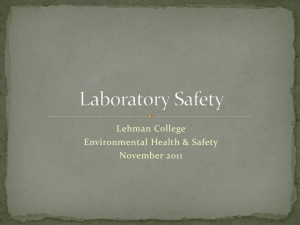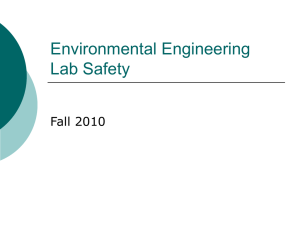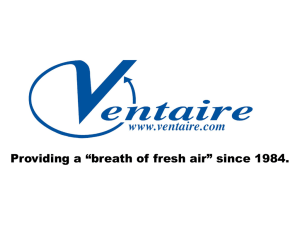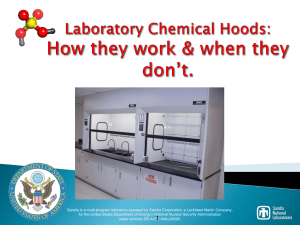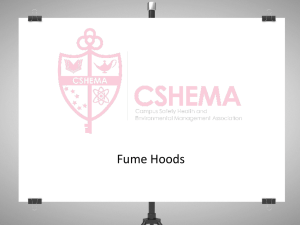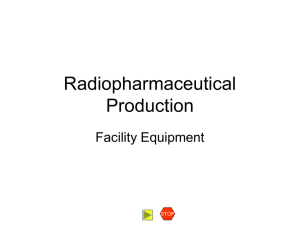fume_hood_presentation
advertisement
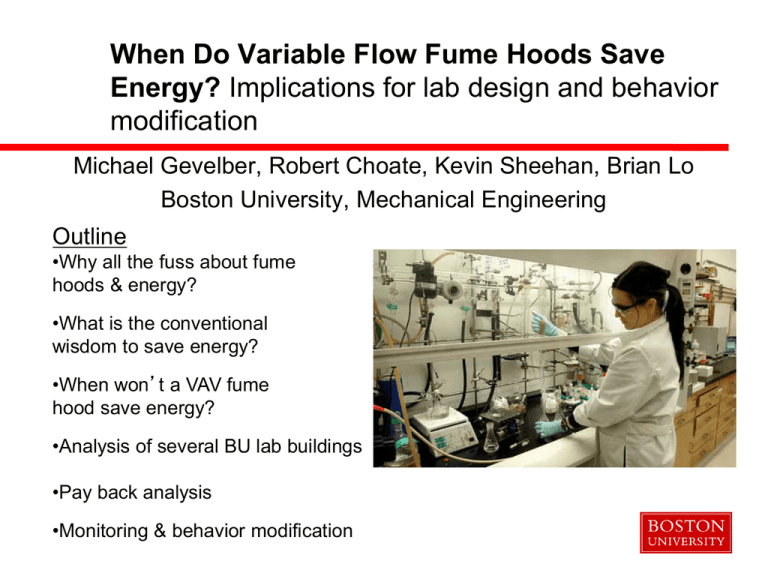
When Do Variable Flow Fume Hoods Save Energy? Implications for lab design and behavior modification Michael Gevelber, Robert Choate, Kevin Sheehan, Brian Lo Boston University, Mechanical Engineering Outline •Why all the fuss about fume hoods & energy? •What is the conventional wisdom to save energy? •When won’t a VAV fume hood save energy? •Analysis of several BU lab buildings •Pay back analysis •Monitoring & behavior modification How much energy/$ does a fume hood use? LBL Fume Hood Energy Model: Provides basis to use local climate, energy rates, efficiency to calc $/cfm & load costs http://fumehoodcalculator.lbl.gov/index.php • For $3.38/cfm, a 1000cfm hood costs $3,380/year • Analysis by Mills and Sartor, LBL 2005 paper National Impact of Fume Hoods • Mills and Sartor 2006 paper • Significant energy use in US: ~750,000 hoods $4.2 billion/yr, 5100 MW of electric demand 26 TWh of electricity & 193 X 1012 BTU/yr • Solutions – New designs – What to do about existing hoods? • Variable close the sash • Constant volume should they be changed to variable? Question: When will these solutions for existing hoods really pay off? Should we use variable for new hoods? What Does University Websites Say to Do? Johns Hopkins • A fume hood consumes 3.5 times the amount of energy consumed by the average house • One simple action can make the difference between a wasteful lab and a responsible lab: CLOSE THE SASH! Stanford University • Fume hoods are big energy hogs because they use so much conditioned air. When the fume hoods are not in use but left open, a tremendous amount of energy is wasted by the conditioned air flowing through the hoods and out of the building. Cal Tech • Shut your sash! - A variable volume fume hood is 60% more energy effective when the sash is down when not in use • One fume hood uses as much energy as 3 typical American homes University of Notre Dame • Keeping just one variable air volume hood closed when not in use rather than leaving it open all the time saves $1,000 a year and is equivalent to taking 3 cars off the road. Pennsylvania State University • With several hundred fume hoods at Penn State, we could save $250,000 to $500,000 in energy costs if the sashes are closed when the fume hoods are not being used. Is it as simple as it seems? No! Need to view the hood as part of the room’s HVAC system. Variable Volume Fume Hoods • System maintains constant face velocity, varies flow rate • High capital cost but lower operating costs – IF the sash is closed • Easy, inexpensive modification with large return – Reduce face velocity to 100 ft/min – Education and monitoring program Photo Credit: oregonstate.edu/vent/bypass Constant Volume Fume Hoods • “Constant” air flow regardless of sash height • Lower capital cost, higher operating cost • More challenging and expensive retrofit: need a variable speed [ventilation fans/motors] – Rebalance air system – Reduce flow rate when closed using a low position sensor – Minimize face velocity to 100 ft/min Photo Credit: www.research.northwestern.edu/ors/labsafe/hoods BU Fume Hood Background • 385 fume hoods on Charles River campus – $1.5 million (~$4K per hood) in fume hood energy use costs – 34% variable 66% constant – Several new lab buildings and rehab, done with phoenix valves, and all variable fume hoods. What should we do to reduce waste? - launched study to investigate cost of converting constant to variable Hood/Room Exhaust Savings Analysis Q hood Hood Exhaust Q gen • Total exhaust includes: Q hood+ Q gen • Min total exhaust based on room ACH • Lab safety requirements: 6<ACH<12 If , No Savings Hood/Room Exhaust Savings Savings per Hood 900 Savings Depend on: • ACH spec: 6 – 10 500 • Hood min/ max flow • User behavior • Need to redo analysis for different size hoods Savings per hood CFM • No. of Hoods in room 700 – UnOcc ACH reduction (4) ACH 6 800 ACH 8 600 400 ACH 10 63%-88% of “expected savings” 300 30%-70% of “expected savings” 200 100 0 1 2 3 4 5 6 Number of hoods 7 8 Assumptions:1000 sq ft room 1000 cfm hoods What Are Payback Implications? • What is relative cost savings if switch/design continuous to variable hoods? # Hoods/Room “Expected” Yearly Savings Actual Savings ∆Cost of VAV “Expected” Payback Actual Payback 2 Hoods $4,000 $1,600 $20,000 5 years 12.5 years 3 Hoods $6,000 $3,600 $30,000 5 years 8.3 years • Assumes: 1000cfm Hood, $4/cfm, $10,000 per hood Closed 50% of time Spreadsheet calculator for actual fume hood savings Can extend to actual savings by using $/cfm A Look at Fume Hoods in 3 Lab Buildings at BU Photonics 8 St. Mary’s St • 290,000 ft2 • 32 Fume Hoods Life Sciences 24 Cummington • 148,000 ft2 • 79 VAV Hoods • 10 CV Hoods Science Center 590 Comm • 284,000 ft2 • 169 Fume Hoods Hood Density Per Room No Savings Photonics 24 Cummington 20 25 No Savings 18 Number of Rooms Number of Rooms 16 14 12 10 8 6 4 2 20 15 10 5 0 0 1 2 3 4 5 6 7 8 10 1 2 3 4 Fume hoods Per Room Fume Hoods Per Room Implications 590 Commonwealth No Savings In many cases, if just 1 fume hood in room, should be constant volume & used as part of room exhaust. 40 Number of Rooms 35 30 25 20 15 –what ACH is required for safety? 10 5 0 1 2 4 6 Fume Hoods Per Room 8 10 –how implement safe unoccupied mode for room down to 4 ACH Fume Hoods Size (cfm) Distribution Photonics 30 14 25 12 Numer of Fume Hoods Number of Fume Hoods 24 Cummington 20 15 10 5 8 6 4 2 0 0 400 600 800 1000 1200 1400 1600 1800 Fume Hoods Size (cfm) 60 50 40 30 20 10 0 600 800 1000 Fume Hood Size (cfm) More 400 600 800 1000 1200 • Red indicates one hood per room 70 400 2000 Fume Hoods Size 590 Commonwealth Number of Fume Hoods 10 2000 More Fume Hood Position Monitoring System For Behavior Modification • Use Building Automation System to track which hoods are left open – Report on monthly basis to lab managers, staff, & professors – Need a champion in building, track only hoods that matter • Simple iterative algorithm • Lots of people will take your $ to provide a fancy system, but the above is easy to implement Trial Monitoring Results 1 Day Dynamic Results Average over 70 days 120 828.1 100 80 828.4 848.3 724.2 60 828.2 40 20 0 12 AM 848.1 828.5 724.1 AVG Percent Open Fume Hood Open Percent 120 100 80 60 50% 40 20 0 4 AM 8 AM 12 PM 4 PM 8 PM •828.1, 828.4 never close their hoods •724.2 seems to be open at 70% 24/7 828.1 828.2 828.4 828.5 848.1 848.3 724.1 724.2 Fume Hood •724.1, 848.5, 848.1 doing a decent Job •848.3 Modulates, but why not close more? Summary • Hoods are energy hogs, BUT we need to look how they function as part of room and building HVAC systems to figure out potential savings • Savings for VAV Hoods likely to be less for rooms with only 2-3 hoods in them, maybe none for 1. • For those rooms where there’s an impact, consider Fume Hood monitoring, large variation of behavior & changes term by term Comparative Analysis of Two Size Hoods Q_hex_max = 800cfm, Q_hex_min = 200cfm Q_hex_max = 1200cfm, Q_hex_min = 200cfm Average Over 70 day 120 Avg Percent Open 100 80 60 40 20 0 828.1 828.2 828.4 828.5 848.1 Fume Hood 848.3 724.1 724.2 1 day Dynamic Results 120 Fume Hood Open Percent 100 80 60 40 20 0 12 AM 4 AM 8 AM 12 PM Time 4 PM 8 PM

